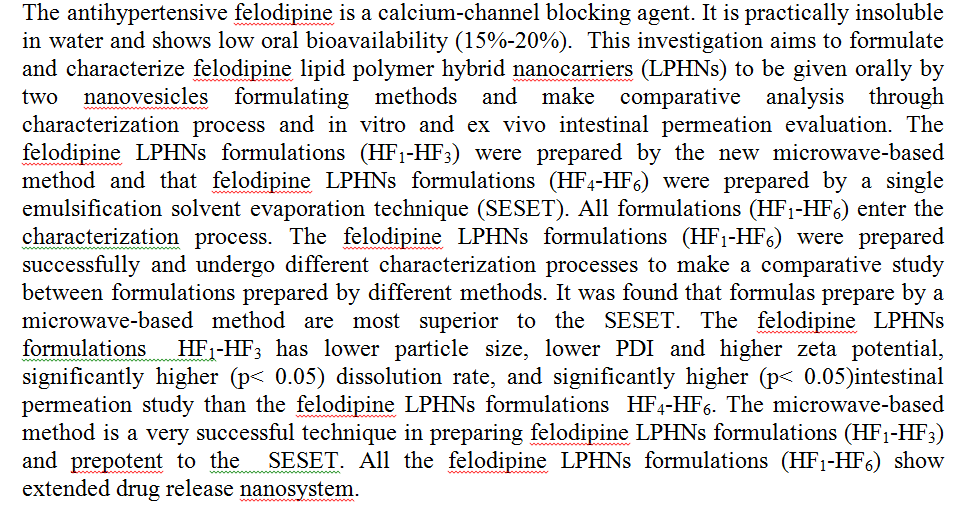Silymarin (SM) is a plant extract obtained from Silybum marianum( milk thistle) . It is class II type drug according to Biopharmaceutics Classification System with low bioavailability due to its low solubility.
Micro/nanonization during crystallization, surface modification and crystal structure modification may improve the dissolution rate of poorly water-soluble drugs.
The aim of this study was to increase the water solubility and dissolution rate of SM by in-situ micronization using solvent change either by stirring or ultrasonic method. Stabilizers like Gelatin, PVP-K30, HPMC15, Pulullan were used to stabilize the prepared ultrafine crystals. Effect of type and concentration of hydrophilic polymer, solv
... Show More (6)
(6)
 (2)
(2)
Addition of bioactive materials such as Titanium oxide (TiO2), and incorporation of bio inert ceramic such as alumina (Al2O3), into polyetheretherketone (PEEK) has been adopted as an effective approach to improve bone-implant interfaces. In this paper, hot pressing technique has been adopted as a production method. This technique gave a homogenous distribution of the additive materials in the proposed composite biomaterial. Different compositions and compounding temperatures have been applied to all samples. Mechanical properties and animal model have been studied in all different production conditions. The results of these new TiO2/Al2O3/PEEK biocomposites with different
... Show More (1)
(1)
 (1)
(1)
 (7)
(7)
 (5)
(5)
Acinetobacter baumannii (A. baumannii) is a major opportunistic nosocomial pathogen, mostly resistant to several groups of antibiotics. Colistin is now used as a last-line treatment for isolates that are highly resistant. The purpose of this study is to identify the importance of LptD; which is involved in the translocation of LPS from the inner membrane to the outer membrane in compartment with LptA and LptC of A. baumannii and its indispensable role as a virulence factor, and the efficiency of colistin as a monotherapy. In the current research, two isolates of A.baumannii were used, the local isolate HHR1 isolated from urine sample and the global strain ATCC 17904, and three antibiot
... Show More (1)
(1)
 (14)
(14)
 (9)
(9)
This paper presents comprehensive analysis and investigation for 1550nm and 1310nm ring optical modulators employing an electro-optic polymer infiltrated silicon-plasmonic hybrid phase shifter. The paper falls into two parts which introduce a theoretical modeling framework and performance assessment of these advanced modulators, respectively. In this part, analytical expressions are derived to characterize the coupling effect in the hybrid phase shifter, transmission function of the modulator, and modulator performance parameters. The results can be used as a guideline to design compact and wideband optical modulators using plasmonic technology
The ring modulator described in part I of this paper is designed here for two operating wavelengths 1550nm and 1310nm. For each wavelength, three structures are designed corresponding to three values of polymer slot widths (40, 50 and 60nm). The performance of these modulators are simulated using COMSOL software (version 4.3b) and the results are discussed and compared with theoretical predictions. The performance of intensity modulation/direct detection short range and long rang optical communication systems incorporating the designed modulators is simulated for 40 and 100Gb/s data rates using Optisystem software (version 12). The results reveal that an average energy per bit as low as 0.05fJ can be obtained when the 1550nm modulator is d
... Show MoreThis study is carried out on patients with type 2 diabetes mellitus to assess the lipid profile, malondialdehyde and glutathione. Our study is concerned with 51 (Iraqi Arab females) patients of type 2 diabetes mellitus compared with 31 control subjects unified in age, sex and ethnic background. Lipid profile is measured by using commercially available kits, while the serum MDA and glutathione levels are measured by means of sandwich ELISA test using commercially available kits. Serum MDA is significantly higher (P<0.001) while glutathione is significantly lower (P<0.001) in type 2 diabetic patients when compared to the control. The normal levels of MDA (3.82 ± 0.77n mol/ml) and GSH (2.23 ± 0.54 µg/ml) recorded for the non-diabetic female
... Show MoreA niger, a fungus which doesn't have high ability to production lipid, this fungus has been select to investigate the non oleaginicity. In this search, there are explorations about: i) growth profile ii) enzymes profile iii) isoforms. Growth profile shows that this fungus doesn't have ability to accumulate lipid more than 6% while bio mass are around 10g/l in spite of the presence of glucose in the media till the end of cultivation time and excision of nitrogen within 24 hrs. In enzyme study, we investigate all lipogenic enzymes Malic enzyme (ME), Fatty acid synthase (FAS), ATP: Citrate lays (ACL), NAD+ isocitrate dehydrogenase (NAD+ICDH), Glucose-6-phosphate (G6PD), and 6-phosphogluconate dehydrogenase (6PGD), all these enzymes show, ac
... Show More (1)
(1)

